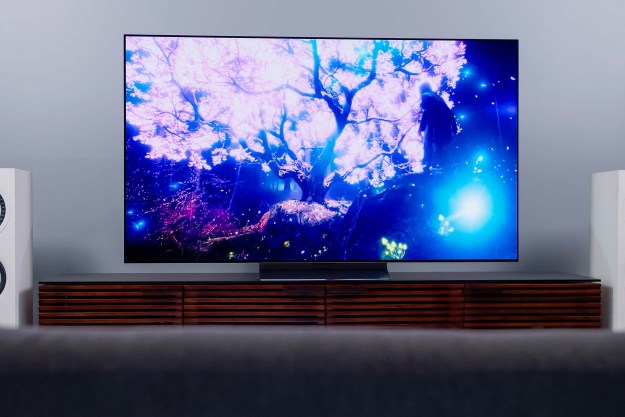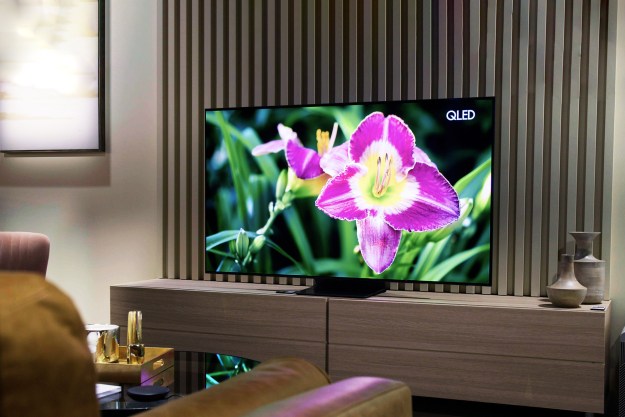- Excellent sound; Plenty of power; THX certified; several processing modes
- Lacks TrueHD and HDMI passthrough; minor design foibles
Summary
Logitech’s Z-5500 5.1 speakers, one of our all-time favorite picks, suffer from a serious flaw: They’re just too darn good. Though a couple lower-powered 5.1 options have made their way to the shelves since their introduction a couple years ago, the Z-5500s stubbornly refuse to budge from the top of the pile. Amazingly, considering these suckers are readily available and have been for some time now, we still can’t find a better option for discerning audiophiles. Continue reading to hear the highs, lows (and, of course, mids) of these sweet-sounding gems.
Features and Design
You may be asking yourself, “Why are we seeing a review of a two year-old product on the always hip, always up-to-date Digital Trends?” The answer is simple: They still can’t be beat when it comes to overall quality. And frankly, the longstanding crème de la crème of Logitech’s speaker line deserves a little attention for smacking down the competition for so long.
As of publication, Logitech has three 5.1 speaker options available: The budget-priced X-540, the gamer-targeted G51, and the home theater enthusiast-ready Z-5500. Just looking at the power rating is enough to give the reader an idea of where each lies in terms of the performance (and price) spectrum. The X-540 tops out at 70 watts, the G51 sports 155 watts, and the Z-5500 coyly flaunts its 505 watts or raw power. Of course, it’s worth mentioning that the low-end X-540 is the result of several revisions since the Z-5500 was introduced, and that the G51 is the latest addition to the family. This makes us suspicious that a refresh to the Z-5500 is in the works (though no details on rumored replacements have yet surfaced on our radar).
Anyways, the Z-5500 comes packed with four 62 watt satellite speakers, a 69 watt center channel unit and a 188 watt subwoofer. Each satellite driver measures 3”, with the subwoofer fitted with a 10” high-excursion ported driver. The THD is a disappointing-on-paper 10% which, although most home theater enthusiasts would scoff at that number and only consider <5% an acceptable range, in practice we found sound accuracy to be surprisingly excellent. All speakers run to the powered subwoofer, which is controlled by the wired remote.
The wired remote itself is where all the action occurs. There are ports for up to 6 input devices and a headphone out port, which disables the speakers when in use. Mind you, we’re torn over whether we actually like the inputs running to the control pod, as it adds some wire clutter to the desktop. Other options place inputs on the subwoofer, which might be more ideal from a neat-freak’s perspective. But truthfully, we liked the accessibility of having all the inputs within arm’s reach. All cords can be bound to the remote’s wire though, ultimately making this a non-issue. Options include 6-channel direct input via three stereo mini-plugs, optical, digital coax and stereo microphone.
Image Courtesy of Logitech
Curiously, however, the main control pod/remote is a desktop fixture as much as a useful control panel. And while the unit’s size is somewhat annoying on cluttered workspaces, it does offer quick access to a number of handy functions. The blue backlit LCD is easily readable and displays the current input settings. Nearly every aspect of the sound can further be configured using a button and the volume knob. Subwoofer power, surround channel volume (fade), surround delay, center channel volume and several other options are also available in different processing modes. You can additionally elect to pass the signal straight through from an external decoder, such as your PC card, or decode from the digital inputs. The microphone/auxiliary input also supports stereo. For analog audio sources, Dolby ProLogic II Music and Movie settings are available, as are stereo and dual stereo (mirrored audio on the rear channels).
We should point out, however, that the wireless remote feels cheap and is mostly pointless for desktop use. The only case where it might be useful is when using the Z-5500 instead of a proper home theater receiver. Otherwise, it will be cast into the basket of useless accessories. To be blunt, including it was a nice thought, but either make the remote match the quality of the rest of the system or leave it out entirely.
To make a long story short, we’ve used the Logitech Z-5500s on a daily basis for over a year, and had zero operating, 
We did have to tune down the bass a little, and boost power to the four surround satellites in order to get a nice, even sound field. Still, this took a very small amount of fiddling, and with all of it done with the control pod rather than PC software, we quickly hit a configuration that has remained untouched for nearly our entire ownership period. Having auditioned a little over a dozen 5.1 PC setups, we can safely say these are the best-sounding computer speakers we have heard. They even beat out the Klipsch ProMedia 5.1s that failed twice within a year and which served as our previous home setup. (Though on the sound quality front the battle was close…)
As a quick note, most audiophiles will suggest that buying a low-end receiver and several bookshelf speakers will provide better sound than any available PC-ready speaker set. For the most part, this is true, but requires matching speakers, pricing multiple components, turning on separate power sources and powering all that on the same circuit as the rest of your office equipment. We would caution that in a world where a 1500 watt PC power supply has just been announced, you may be tripping surge protectors every time you try to use your printer or document shredder as well. Also, a single solution offers a single point of contact for any problems, and our past experience with Logitech’s hardware has been exemplary. The Z-5500s compare favorably to the sound you’ll get from a dedicated setup, and add a level of ease and simplicity that is undeniable.
So, with such a rocking system, where is there room for improvement? Our list is predictably short, and nit-picky, though we expect to see some of these upgrades in whatever replaces the Z-5500. First, we’d recommend updating the decoders to offer Dolby TrueHD, Dolby Digital II and DTS-HD to keep up with the these heady days of HD-DVD and Blu-Ray players (and, perhaps, HDMI passthrough). The speaker wire also needs upgrading to something thicker than a human hair. Stands should be designed so that they can be aimed at a downward angle when sitting on a bookshelf too. (As is now, the speakers angle upwards when sitting on a flat surface and down when switched into a wall-mounted configuration, and associated stands cannot be easily removed or inverted.) Finally, a smaller, but equally powerful subwoofer would prove a nice addition as well. (Some companies such as Yamaha have been able to release some nice subs with smaller footprints, which can prove a premium when looking at PC speaker setups.)
At $400 USD a shot, Logitech had best be sure to keep the Z-5500, or its replacement, up-to-date or run the risk of facing stiffer competition from weaker systems with the latest whiz-bang technology. Inside tip, however – don’t worry about actually paying the full MSRP, as the Z-5500 can be found at several outlets in the $250 USD range.
Conclusion
The Logitech Z-5500 is the best all-around PC speaker system we have used to date. The sound quality is first-rate, the system looks stylish and the added features/decoders are merely frosting on the cake. Though the system is now slightly dated, the Z-5500 is that rare breed of gadget that, even when an update does come down the pipeline, we would not have any regrets having purchased. As far as PC speaker setups go, you can’t do much better in terms of overall performance and feature set – go get you some.
Pros:
• Excellent sound
• Plenty of power
• THX certified
• Several processing modes
Cons:
• Lacks TrueHD and HDMI passthrough
• Minor design foibles
Editors' Recommendations
- The best universal remotes for 2023
- Samsung S95C OLED hands-on review: it’s time to get excited
- The absolute best tech we reviewed last month
- NuraTrue Pro hands-on review: A sneak peek at the lossless future of wireless audio
- Sonos Voice Control hands-off review: Now we’re talking






